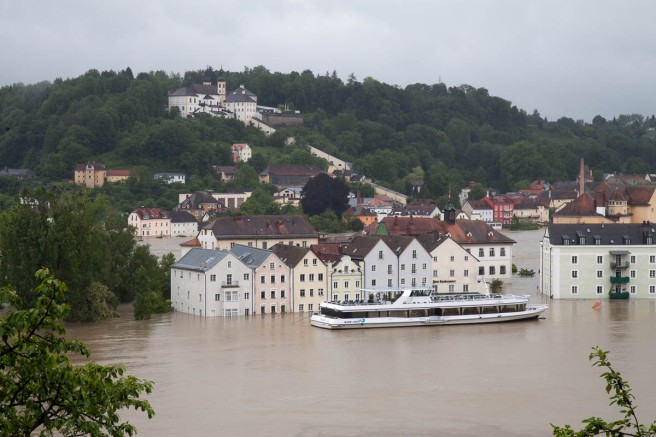By Ed Challies
Floods are the most frequently occurring natural disaster globally, and flood damages are expected to increase drastically over the coming decades due to climate change, demographic trends, and on-going development on flood plains. This will play out differently and pose unique challenges in different regions, and Europe is no exception. Floods in Europe inflict greater economic losses more frequently than any other natural hazard, with trillions of Euros worth of assets and millions of people exposed (see Jongman et al. 2012). A recent study reported by the Europe Joint Research Centre predicts annual damages to rise from EUR 5.6 to 40 billion by 2050, and the number of people affected to rise from 200 thousand to over half a million over the same period.
With projections such as these, it is no wonder that the challenge of better managing (and reducing) flood risk is high on the political agenda in Europe. The recurrence of severe floods, like those on the Elbe and Danube rivers in 2013, and the 2015-16 floods in Britain and Ireland, only serve to heighten the sense of urgency among citizens and officials. In some ways this serves to increase awareness and engagement and provide impetus for action at multiple levels – from households and municipalities right up to member states and the European Union. On the other hand, the high stakes and direct threat that floods pose to human wellbeing, present challenges for flood risk management planning. This is particularly so in light of the current policy shift away from the previously dominant paradigm of flood protection and defence, and towards a more integrated flood risk management approach. Most importantly, this entails the management of risk (as opposed to the management of floods), and implies the negotiation of socially acceptable levels of exposure and risk – an issue that is inevitably sensitive and often controversial.
 Photo: Flooding in Passau (Inn/Danube), Germany, 2013. Licence CC BY-SA 2.0; Stefan Penninger.
Photo: Flooding in Passau (Inn/Danube), Germany, 2013. Licence CC BY-SA 2.0; Stefan Penninger.
Flood risk is commonly defined as comprising (1) the magnitude of flood hazard (frequency and severity), (2) the exposure of human activities, and (3) the vulnerability of exposed elements. There are, therefore, multiple points for intervention to address and mitigate flood risk, ranging from information and awareness-raising campaigns and early warning systems, to flood protection measures, land-use planning and ‘ecological’ measures such as wetland restoration and afforestation. In this sense, efforts to confront flooding touch on a wide range of activities, policy fields and stakeholders within river basins. No wonder, then, that flood risk management is typically characterised by high stakes, competing interests, and conflict!
With the aim of improving the effectiveness and legitimacy of flood risk management, participatory and collaborative approaches are increasingly advocated, which should bring stakeholders and the affected public on-board in planning and decision-making. One prominent development in this direction in the European context is the 2007 Floods Directive, which aims to reduce the effects of flooding through an explicitly participatory approach to cyclical planning. Under the Directive, member states are legally obliged to encourage the active involvement of all interested parties in the planning process. Because every country and responsible authority is starting from a different baseline in terms of flood risk management and participatory governance, however, an array of approaches are currently unfolding across the EU. The rationale behind this ‘mandated participatory planning’ approach (Newig & Koontz 2014) is very much an instrumental one: The European Commission expects that it will produce better plans, more widely accepted and implementable measures, and more effective flood risk management.
Precisely because so much stock is put in participatory approaches to deliver improved and effective planning and management, there is a need to examine how participatory public decision-making is playing out in the field of flood risk management, and to consider what potential participation holds. Participatory and collaborative approaches in environmental planning and management more widely have certainly had mixed success in terms of achieving legitimacy and effectiveness. What about the field of flood risk management poses particular challenges for participatory planning and implementation? What potential do participatory approaches hold for fostering sustainable and just flood risk management? These questions motivate a recent special issue of Environmental Science and Policy jointly edited by members of our research group here at Leuphana University, and drawing together twelve contributions from leading scholars in the field. The collection examines, from a variety of disciplinary perspectives, some of the key issues around justice and power, acceptance and legitimacy, social learning, multi-level governance and policy integration, and governance learning in flood risk management.
With climate change and developmental pressures continuing to exacerbate multiple drivers of flood risk, it will be crucial for research to focus on how policy and governance responses perform in mitigating this risk. As authorities like the EU increasingly advocate participatory approaches, but recurring flood events continually trigger calls to revert to expert-led planning and engineered flood protection solutions, researchers must also critically examine collaborative planning. This should ideally be done in partnership with authorities and practitioners in ways that can support transdisciplinary learning and adaptation – not only about effective measures for sustainable flood risk management, but also about how to conduct effective and legitimate participatory planning towards this end.
Special Issue: Check out the special issue in Environmental Science and Policy: Participatory and Collaborative Governance for Sustainable Flood Risk Management: An emerging research agenda ♦ (Edited by Ed Challies, Jens Newig, Thomas Thaler, Elisa Kochskämper, and Meike Levin-Keitel).
References
- Jongman, B., Ward, P. J., & Aerts, J. C. J. H. (2012). Global exposure to river and coastal flooding: Long term trends and changes. Global Environmental Change, 22(4), 823-835.
- Newig, J., & Koontz, T. M. (2014). Multi-level governance, policy implementation and participation: The EU’s mandated participatory planning approach to implementing environmental policy. Journal of European Public Policy, 21(2), 248-267.
